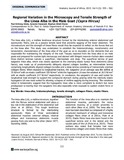Regional variation in the microscopy and tensile strength of the linea alba in the male goat (capra hircus).

View/
Date
2015Author
Odula, Paul
Hassanali, Jameela
Kiama, Stephen
Type
ArticleLanguage
enMetadata
Show full item recordAbstract
The
linea alba
(LA)
, a midline tendinous structure formed by the interlocking anterior abdominal wall
aponeurotic fibers, acts as a passive tensile band that prevents sagging of the lower abdomen.
The
microstructure and the strength of these fibres would
thus
be expected to reflect
on
the forces that act
on the linea alba. This study was undertaken to establish
the histomorphology, morphometry and
tensiometric characteristics of the linea alba of th
e goat so as to elucidate on the elements that are
responsible for maintaining the integrity of the wall.
T
issues
resected from the l
inea
alba
in
six
male
goats
and prepared for
routine light
microscopy
and stained with Weigert resorcin
–
fuchsin stain
revealed
three distinct laminae namely a superficial, intermediate and deep. The
superficial lamina of goat
epigastric
linea alba
, which was
closely apposed to the overlying elastic tunica
flava abdominis (deep
fascia),
was made up of predominantly oblique
ly aligned collagen bundles, an intermediate lamina
comprising longitudinally aligned collagen bundles and a deep lamina consisting of transversely oriented
collagen fibres.
When exposed to longitudinal traction,
t
he
epigastric LA on average
was
the stiffest at
35
N/mm
2
with an elastic coefficient 350 N/mm
2
while the hypogastric
LA
was
the weakest at 2
6
.5
N/mm
2
with an elastic coefficient 217 N/mm
2
respectively
.
In conclusion,
t
he epigastric
LA was well suited for
longitudinal load strength to support the compound stomach during grazing while the relatively elastic
hypogastric
LA was most suited for
allowing a degree of
midline sagging during browzing.
The variati
ons
noted in tensiometry sugge
st
that the hypogastric linea alba is more compliant to stretch but more
predisposed to tearing than the epigastric line alba especially when exposed to sudden violent force or
trauma
Citation
Odula, P. O., Hassanali, J., & Kiama, S. G. Regional Variation in the Microscopy and Tensile Strength of the Linea Alba in the Male Goat (Capra Hircus). Anatomy Journal of Af rica. 2015. Vol 4 (2): 555 – 562 .Publisher
University of Nairobi
